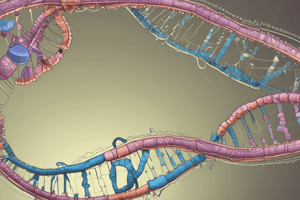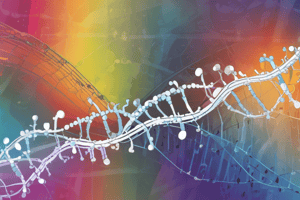Podcast
Questions and Answers
What determines the shape and function of a protein?
What determines the shape and function of a protein?
- The codon sequence
- The number of amino acids
- The order of amino acids (correct)
- The type of amino acids
How many stop codons are there in genetic coding?
How many stop codons are there in genetic coding?
- 1
- 3 (correct)
- 2
- 4
What is the role of tRNA in protein synthesis?
What is the role of tRNA in protein synthesis?
- It transports amino acids to the ribosome (correct)
- It carries the genetic code from DNA
- It synthesizes proteins directly
- It forms the structure of the ribosome
Why are there more codons than amino acids?
Why are there more codons than amino acids?
What does the codon AUG code for?
What does the codon AUG code for?
Which base is found in RNA but not in DNA?
Which base is found in RNA but not in DNA?
What is the primary function of mRNA?
What is the primary function of mRNA?
Which of the following is NOT a type of RNA involved in protein synthesis?
Which of the following is NOT a type of RNA involved in protein synthesis?
What process involves making a copy of a gene in the form of RNA?
What process involves making a copy of a gene in the form of RNA?
Where does transcription occur in eukaryotic cells?
Where does transcription occur in eukaryotic cells?
What characterizes a point mutation?
What characterizes a point mutation?
What happens during a frameshift mutation?
What happens during a frameshift mutation?
What is an insertion mutation?
What is an insertion mutation?
Which of the following is an example of a chromosomal mutation?
Which of the following is an example of a chromosomal mutation?
What role does RNA polymerase play in transcription?
What role does RNA polymerase play in transcription?
What is a mutagen?
What is a mutagen?
What kind of effect can a mutation have on an organism?
What kind of effect can a mutation have on an organism?
Which of the following best describes a deletion mutation?
Which of the following best describes a deletion mutation?
Flashcards
What is transcription?
What is transcription?
The process of copying a gene's DNA sequence into RNA.
What are the two roles of RNA polymerase?
What are the two roles of RNA polymerase?
An enzyme that unzips DNA to allow for copying and then builds an RNA strand matching the DNA template.
Define mutation.
Define mutation.
Change in the DNA sequence of a cell, like a typo in a genetic code.
Define point mutation.
Define point mutation.
Signup and view all the flashcards
Define frameshift mutation.
Define frameshift mutation.
Signup and view all the flashcards
What are chromosomal mutations?
What are chromosomal mutations?
Signup and view all the flashcards
What is a mutagen?
What is a mutagen?
Signup and view all the flashcards
What are neutral mutations?
What are neutral mutations?
Signup and view all the flashcards
What are beneficial mutations?
What are beneficial mutations?
Signup and view all the flashcards
What are harmful mutations?
What are harmful mutations?
Signup and view all the flashcards
Amino Acids
Amino Acids
Signup and view all the flashcards
Codon
Codon
Signup and view all the flashcards
Translation
Translation
Signup and view all the flashcards
Genetic Code
Genetic Code
Signup and view all the flashcards
mRNA (Messenger RNA)
mRNA (Messenger RNA)
Signup and view all the flashcards
tRNA (Transfer RNA)
tRNA (Transfer RNA)
Signup and view all the flashcards
rRNA (Ribosomal RNA)
rRNA (Ribosomal RNA)
Signup and view all the flashcards
Protein Synthesis
Protein Synthesis
Signup and view all the flashcards
Study Notes
Protein Composition and Synthesis
- Proteins are composed of amino acids.
- There are 20 different amino acids.
- The order of amino acids determines a protein's shape and function.
RNA Bases
- The four bases in RNA are adenine (A), uracil (U), cytosine (C), and guanine (G).
Genetic Code
- The genetic code is a set of rules that translates DNA or RNA sequences into proteins.
Codons
- A codon is a set of three RNA bases that codes for one amino acid.
- There are 64 possible codons (4³).
- Multiple codons can code for the same amino acid.
Amino Acid Codons
- UAU codes for tyrosine.
- CGA codes for arginine.
- GCA codes for alanine.
- AGC codes for serine.
AUG Codon
- AUG codes for methionine.
- It also functions as a start codon.
Stop Codons
- UAA, UAG, and UGA are stop codons.
Ribosome Role
- Ribosomes read mRNA and assemble amino acids into proteins.
Translation
- Translation is the process of synthesizing proteins from mRNA.
Steps in Translation (Figure 14.6)
- Initiation: The ribosome binds to mRNA and locates the start codon (AUG).
- Elongation: tRNA molecules deliver amino acids to the ribosome, which links them together.
- Termination: The ribosome encounters a stop codon, releasing the newly formed protein.
- Folding: The protein folds into its functional shape.
Molecular Roles
- mRNA: Carries the genetic code from DNA to ribosomes (recipe).
- tRNA: Delivers amino acids to the ribosome (delivery service).
- rRNA: Forms part of ribosomes, helping assemble proteins (protein-building machine).
Protein Purpose
- Proteins build tissues, catalyze reactions, and regulate processes.
DNA as a Universal Code
- DNA's genetic code is universal, used by all living organisms.
DNA vs. RNA Differences
- Sugar: DNA has deoxyribose; RNA has ribose.
- Strands: DNA has two strands; RNA has one strand.
- Bases: DNA uses thymine (T); RNA uses uracil (U).
RNA Function
- mRNA: Carries genetic instructions from DNA to ribosomes.
- tRNA: Matches amino acids to codons.
- rRNA: Forms part of ribosomes, facilitating protein synthesis.
Transcription
- Transcription is the process of creating an RNA copy of a gene from DNA.
Transcription Location (Eukaryotes)
- Transcription occurs in the nucleus.
RNA Polymerase Roles
- Unzips DNA: Allows DNA to be copied.
- Builds RNA strand: Matches RNA bases to the DNA template.
Mutation Definition
- A mutation is a change in the DNA sequence.
Mutation Causes
- Errors in DNA replication during cell division.
Point Mutation Definition
- A point mutation affects one or a few nucleotides.
Point Mutation Types (Figure 14-16)
- Substitution: One nucleotide is replaced by another.
- Insertion: A nucleotide is added.
- Deletion: A nucleotide is removed.
Frameshift Mutation Definition
- Frameshift mutations change the reading frame of the genetic code.
Frameshift Mutation Types
- Insertions and deletions alter the grouping of codons.
Chromosomal Mutation Types (Figure 14-17)
- Deletion: Loss of a chromosome segment.
- Duplication: A chromosome segment is copied.
- Inversion: A chromosome segment flips and reinserts.
- Translocation: A chromosome segment moves to another chromosome.
Mutagen Definition
- A mutagen is an agent increasing the chance of DNA mutations.
Mutation Effects
- Mutations can be neutral, beneficial, harmful, or lethal.
Studying That Suits You
Use AI to generate personalized quizzes and flashcards to suit your learning preferences.




